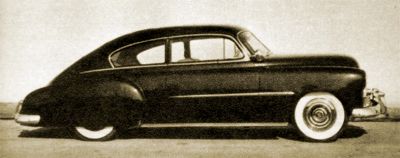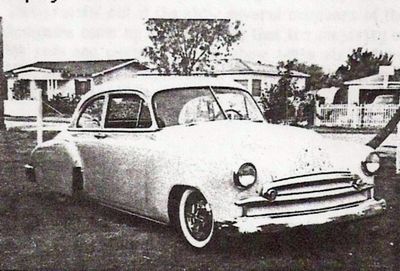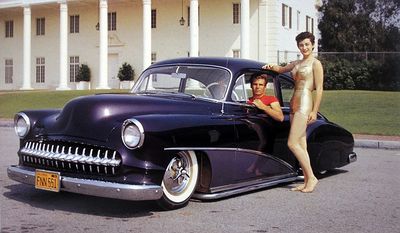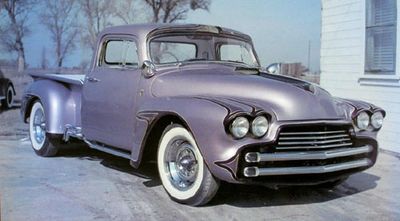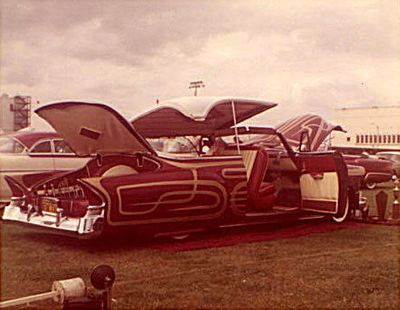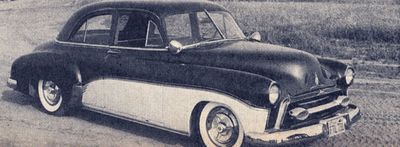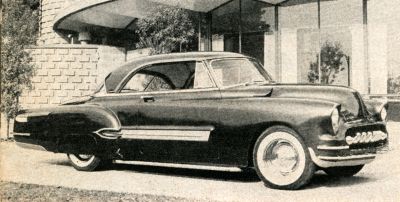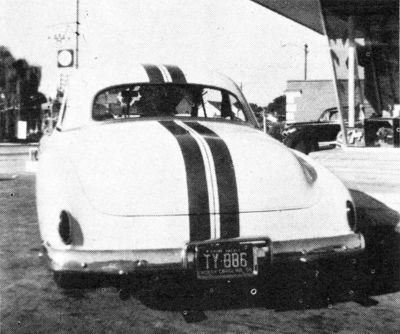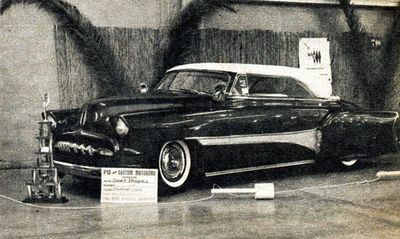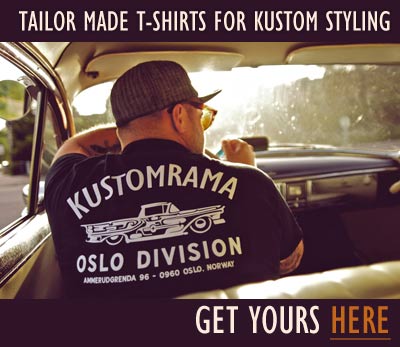
Ralph W. Angel's 1950 Chevrolet. Custom-built by
Spohn Coachworks for
U.S. Air Force Major
Ralph W. Angel while stationed in
Germany, this radical 1950 Chevrolet blended inspiration from concept cars of the time. The rear design heavily borrowed from the
1951 GM LeSabre, while the front styling echoed the futuristic
1953 Lincoln X-100. Featuring a removable padded top, a completely bespoke body, and a custom leather interior with
Spohn’s trademark built-in armrest radio, the car was a marvel of
European craftsmanship. Mechanically, it retained its Chevrolet chassis and engine, enhanced with
dual carburetors and
split exhaust. The build, completed in just six weeks at a cost of $4,500, gained attention in the U.S. upon Ralph’s return, and it was featured in
Cars March 1953. Despite its elegance, Ralph ultimately sold the car to a
Phoenix,
Arizona dealer due to the overwhelming attention it attracted.

Jim Leavitt's 1950 Chevrolet Styleline Tudor of
Redmond,
Washington. Restyled by
Jim Leavitt, foreman at Redmond Pontiac's body shop, this elegant build showcases clever use of GM components. Featuring a
1950 Oldsmobile grille bar, frenched
1951 Ford headlight rings, and Cadillac-inspired rear fenders, Jim's custom achieved a sleek and cohesive look. The
smoothed hood,
shaved deck lid, and electric trunk operation added modern touches, while the black, red, and white interior—expertly stitched by Jim’s wife—brought a personal flair. Powered by a lightly modified engine with dual carbs, Jim’s Fleetline became a standout example of
1950s ingenuity. Once completed, it was featured in
Hop Up October 1953.

Jim Musick's 1950 Chevrolet Bel Air of
Modesto,
California. Built at
Winfield's Custom Shop,
Jim Musick’s Chevrolet exemplified
Gene Winfield’s eye for sleek, flowing design.
Nosed,
decked, and stripped of chrome, the car featured hand-formed fender contours, frenched
1953 Chevrolet headlights, and scoops in front of the rear wheels. The grille showcased a floating centerpiece—a Willys top bar cleverly modified to resemble the letter “M.” Lowered to extremes with a modified frame and de-arched springs, it sat low and lean, accentuated by a flat pink body and black top. Featured in
Rod & Custom March 1954, Jim’s Bel Air remains a benchmark of 1950s California custom style.

Joe Mello's 1950 Chevrolet. Restyled by
Van Leeuwen,
Joe Mello’s Chevrolet showcases the clean and understated custom styling of the early
1950s. The hood was
shaved and leaded for a smooth look, while the stock grille was replaced with a simple straight bar divided by upright Plymouth pieces. Frenched flush headlights added refinement up front, and repositioned taillights completed the flowing design in the rear. Featured in
Trend Book 109 Custom Cars 1954 Annual, this build exemplifies the elegance of mid-century custom craftsmanship.
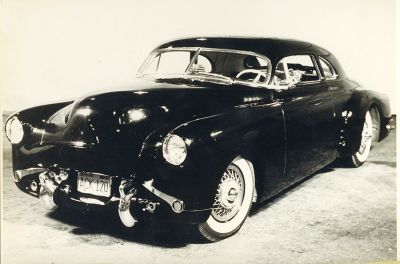
Chuck Rogers' 1950 Chevrolet of
Gridley,
California. Known as
The Black Panther, this radical Club Coupe, built by
Chuck Rogers over 1800 hours, exemplifies
1950s custom craftsmanship. Featuring a 4-inch
chopped top,
frenched headlights, and handmade trim, the car earned its name with jet-black lacquer paint and elegant styling. Inside, highlights included a full bar setup, chromed components, and heart-themed upholstery. The build was completed in
1955. After completion, Chuck secured a job at
Joe Bailon's Custom Shop, cementing his reputation as a master craftsman. The Black Panther remains a celebrated symbol of
1950s innovation and artistry in the custom car world.
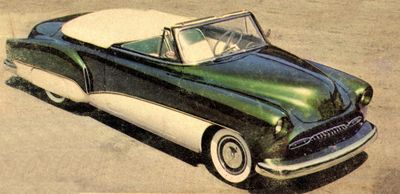
Ted Leventhal's 1950 Chevrolet Convertible of
Oakland,
California. Restyled by
Emory Robinson's Custom Shop for
Oakland Swanx member
Ted Leventhal in
1955, this radical 1950 Chevrolet became a landmark in custom car history. Featuring
recessed headlights,
rounded hood corners, and a handmade grille of chromed copper tubing, the car's design blended creativity with craftsmanship. The taillights were custom-made from clear plastic, while
air scoops and a smoothed rear bumper gave it a streamlined look. Lowered five inches, it sat on flush fender skirts and custom spinners. Painted green
Candy Apple by
Pinoli's Body and Paint Shop, the car is believed to be one of the first
Candy Apple paint jobs. The two-tone green and white interior matched its stunning exterior. Featured in
Car Craft May 1956, the build cost $2,200 and cemented its place as a show-stopping custom of the mid-
1950s.
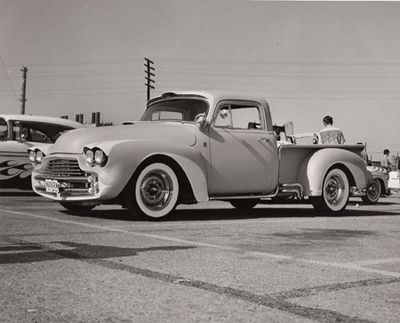
Rod & Custom Magazine's Dream Truck. Owned by
Spencer Murray of
Glendale,
California, the "
Dream Truck" began as a 1950 Chevrolet 1/2-ton designed by
Lynn Wineland with input from
Rod & Custom readers. In
1954, Spencer installed one of the first
Chevrolet V8 engines and used the truck at
Bonneville. Customization started soon after, with
Sam Gates chopping the top and
sectioning the body.
Valley Custom finished the
chop, integrated a custom dashboard, and widened the rear window.
Gene Winfield radiused the wheel wells and
sectioned the hood, while
Barris Kustoms added
quad headlights,
roof scoops, and a molded grille using
1957 Studebaker pans. In
1956, the first version debuted in gray primer with white
scallops.
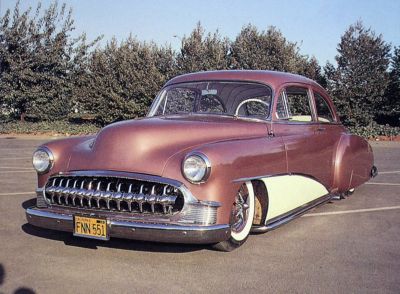
Larry Watson's 1950 Chevrolet of
Bellflower,
California. In this refined iteration,
Larry Watson's 1950 Chevrolet underwent notable custom touches by
Ed Schelhaas of
Bellflower. Featuring a
1953 Chevrolet grille surround with 13 grille teeth,
1956 Buick side trim, and
1950 Buick taillights, the car showcased clean, elegant styling. Ed's painter,
George Newton, applied a striking two-tone paint scheme: ivory lacquer on the bottom and Oldsmobile's metallic "
Rose Mist" on the top. This version, nicknamed
Rose Mist, marked Watson’s growing vision and laid the foundation for his reputation in custom car history.
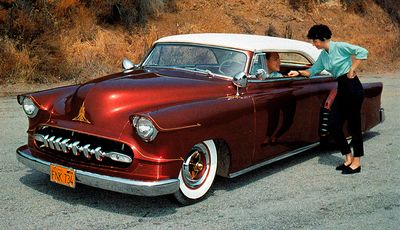
Santo Vasques' 1950 Chevrolet Convertible of
Long Beach,
California. Restyled by
Ed Schelhaas' Custom Shop for
Santo Vasques, president of the
Long Beach Renegades, this radical convertible made a bold statement in
1950s custom culture. Featuring a
chopped 4 1/2-inch windshield from a
1951 Oldsmobile and a custom top utilizing a
1953 Chevrolet Bel Air rear window, the car was a sleek and innovative build. The front end showcased a narrowed
1955 DeSoto grille within a
1953 Chevrolet shell, complemented by hooded
headlights with
1955 Cadillac rims. The body was
nosed,
decked,
shaved, and accentuated with
air scoops on the rear fenders, each fit with four chrome teeth.
Larry Watson added traditional gold
pinstriping and
scallops in
1956, enhancing the
Tahitian Red paint applied by
George Newton. Lowered drastically through C-notched rear suspension and modified A-frames, it hugged the ground, sitting on
Dodge Lancer hubcaps. A cream and red rolls-and-pleats interior completed the elegant design. Featured on the cover of
Car Craft May 1957, Vasques' Chevrolet became a defining custom of its era.

Roger Fleiss' 1950 Chevrolet, of
California. Owned and restyled by
Roger Fleiss, this 1950 Chevrolet featured a sleek, refined look that captured the essence of
1950s custom car style. The car was
nosed,
decked, and
shaved for door handles, while a one-piece
1950 Oldsmobile windshield replaced the stock unit. Up front, a
1955 Plymouth grille and
1955 Chevrolet headlights gave the Chevy a more modern appearance, and flared
1955 Oldsmobile rear wheel openings added flair to the sides. The taillights, sourced from a
1940 Oldsmobile, were accented with subtle pinstriping. Painted red with a white top and featuring a Naugahyde interior, Roger spent 2.5 years perfecting his custom. Once completed, the car earned a feature in
Car Craft May 1957, cementing its place in custom car history.
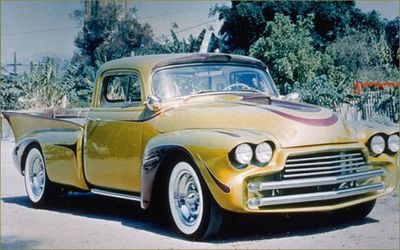
By
1958, the
Rod & Custom Magazine's Dream Truck received its most vibrant transformation.
Larry Watson of
Watson's House of Style applied a striking metallic lime gold paint job, accentuated with bold burgundy
scallops. This version showcased the truck's now-iconic wild canted fins and rear fenders crafted by
Bob Metz, blending futuristic styling with
Watson’s pioneering paint techniques. This rendition marked the Dream Truck's final and most visually daring appearance on the custom car show circuit.

Ron McCully's 1950 Chevrolet of
Eugene,
Oregon. After being sold to
Jim Becker and later
Phil Swaggart of
Eugene,
Oregon,
Larry Watson's Chevrolet continued to evolve. Swaggart named it Heartless for the pleated heart motifs adorning its interior, with local pinstriper
Merle Beebe adding the name to the rear fender panels. The car then passed to
Ron McCully, who modified the column shift with a piston knob and later repainted it solid rose by
1962. Despite its final years of wear, this Chevy remained a dependable driver before ending its journey in the early
1960s, ultimately buried beneath Eugene’s I-5 bridge—a storied icon of custom car history.
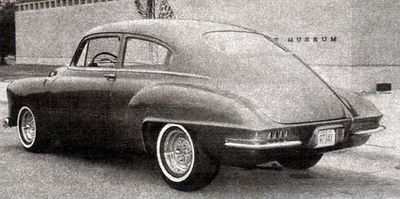
Ronnie Knepp's 1950 Chevrolet Fleetline of
Wichita,
Kansas. After a devastating accident left his 1950 Chevrolet totaled,
Ronnie Knepp turned to
Dave Stuckey of
Stuckey Kustom for a radical restyling. Featuring
asymmetrical rear styling with four hand-formed Lucite taillights on the left side, the car’s unique design set it apart from other customs of the era. The rear pan was rolled, split Corvette bumpers were integrated, and the license plate housing was offset for added flair. The front retained a stock appearance with a
1950 Oldsmobile one-piece windshield. Painted Crystal Green and upholstered in tan and brown Naugahyde by
Paul Mantz, the build combined artistry and craftsmanship. Power came from a modified 1957 Chevrolet engine with ported and polished heads and dual Rochester carburetors. First appearing in
Rod & Custom September 1964, Knepp's Chevrolet exemplifies
Wichita's innovative kustom culture.

After decades of neglect and a near-total loss in a
1958 accident, the
Rod & Custom Magazine's Dream Truck was painstakingly restored in the late
1970s by
Bruce Glascock,
Carl Green, and
Wesley Jones. Reconstructed with precision using period photos as a guide, the truck was painted pearl white with
scallops in burgundy and purple, replicating one of its original show-winning style. Fully roadworthy, the Dream Truck was reintroduced to the custom car scene around
1979-
1980 and remains a legendary symbol of mid-century American automotive creativity.
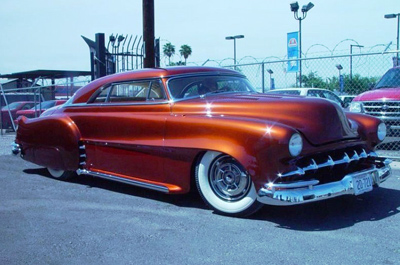
Larry Cochran's 1950 Chevrolet of
Belton,
Missouri. Restyled by renowned customizer
Doug Thompson, this 1950 Chevrolet exemplifies the blending of traditional custom techniques with bold
1980s flair. Featuring a beautifully sculpted and streamlined profile, Thompson’s attention to detail shines through with the sleek body lines, vibrant candy paint, and meticulously smoothed surfaces. Completed in
1986, this build stands as a stunning testament to the enduring appeal of the 1950 Chevrolet in custom car culture.
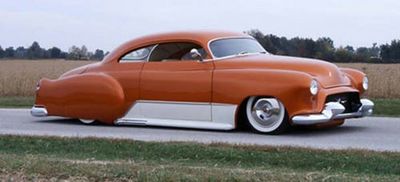
Rob Gerring's 1950 Chevrolet. Designed and fabricated by
Rob Gerring, this Chevy blends traditional custom styling with modern craftsmanship. Featuring a 3-inch
chop,
hardtopped roof, and a
1950 Oldsmobile windshield, the car's lines were modified with a
1941 Mercury rear window,
frenched headlights, and a
pie-sectioned hood. The grille opening was modified with
1956 Cadillac dagmars, and Pontiac side trim complements the streamlined look. Beneath the surface, a Camaro subframe, disc brakes, and
air ride suspension ensure modern performance. Painted Cinnamon Pearl with Snow White Pearl by
Gary Brown, and finished with a two-tone interior by
Martinez Custom Upholstery, Rob’s creation has earned numerous awards, including the
2004 Alexander Brothers Design Achievement Award at the
Detroit Autorama. The build was completed in
2003.

Hillbilly Wes's 1950 Chevrolet Fleetline Deluxe. What began as a rough project car transformed into a striking kustom, built entirely in Wes's barn with help from friends and
Magnetos Car Club members. Featuring a 3.5-inch
chopped roof, Caddy-inspired fins,
Air Ride suspension, and
scalloped blue primer paint, Wes's creation blends traditional style with personal flair. Completed in
2005 after three years of meticulous work, the car earned multiple awards, including “Best Kustom” at the
Pirate Kustom Picnic and “Best Home Built Kustom” at the
Hotrod Hoedown. Built to run the road, Wes's Fleetline reflects his lifelong passion for hot rodding and the joy of cruising with pipes purring and a gal by his side.
<-- 1949 Chevrolet - 1951 Chevrolet -->
The 1950 Chevrolet is a classic American car that has become a staple of custom car culture since its introduction. Its iconic design and affordability made it a popular choice for customization, beginning in the 1950s and continuing to the present day. Enthusiasts and builders from various eras have transformed the 1950 Chevrolet into rolling works of art, showcasing their creativity and innovation.
Early Customizations - The 1950s
In the 1950s, the post-war car culture boom saw the 1950 Chevrolet emerge as a favorite platform for customizers. Builders embraced the car's smooth lines and relatively simple construction, making modifications such as chopping the roof, shaving door handles, and installing custom grilles. Lowering the car's suspension to achieve a sleek, ground-hugging stance was also a common practice. The era's customizers often added accessories like lake pipes, fender skirts, and spotlights to enhance the car's aesthetic.
One notable example from this period is Larry Watson's 1950 Chevrolet, a car that evolved through several distinct iterations in the 1950s, each helping to define styles and trends in custom car culture. Initially used as a canvas for Watson's early pinstriping experiments, the car debuted with simple modifications like lowered suspension, fender skirts, and pinstriped details. Over time, it transformed into the "Rose Mist" version with a two-tone paint job and refined bodywork, followed by the iconic "Grapevine" iteration featuring metallic grape paint, molded body seams, and heart-shaped pleated upholstery. This evolution not only showcased Watson's growing skills but also set new standards for creativity and craftsmanship in the custom car scene, influencing builders for decades to come.
The Rise of Radical Customs - The 1960s-1970s
As the 1960s and 1970s unfolded, customizers began experimenting with more radical modifications to the 1950 Chevrolet. Metalflake paint jobs, candy colors, and intricate pinstriping became hallmarks of the era. Builders also started integrating modern elements like quad headlights and updated taillights, blending old-school aesthetics with futuristic flair. These cars often debuted at car shows, competing for trophies and inspiring a new generation of customizers.
During this time, lowrider culture also embraced the 1950 Chevrolet. With intricate hydraulic systems and vibrant paint schemes, lowrider versions of the car became icons in their own right, symbolizing pride and craftsmanship in communities across the United States.
Contemporary Customizations - 1980s-Present
The 1980s and beyond have seen a resurgence of interest in traditional customs, with builders seeking to honor the classic styles of the 1950s and 1960s. Restored and retro-styled 1950 Chevrolets often feature period-correct modifications, such as tuck-and-roll interiors, whitewall tires, and vintage hubcaps. Meanwhile, modern builders have pushed the boundaries of customization, incorporating advanced techniques like air suspension, modern drivetrains, and custom fabrication to create unique showpieces.
Notable contemporary builds include Larry Cochran's 1950 Chevrolet, which combines traditional customization techniques with modern engineering to deliver a striking blend of past and present.
Cultural Impact
The 1950 Chevrolet has left an indelible mark on car culture, appearing in countless car shows, magazines, and movies. Its status as a canvas for artistic expression has made it a beloved choice among customizers worldwide. From classic hot rods to show-stopping lowriders, the 1950 Chevrolet continues to inspire and captivate enthusiasts of all ages.
This page serves as a tribute to the timeless appeal of the 1950 Chevrolet and the ingenuity of the builders who have transformed it over the decades. If you have a customized 1950 Chevrolet or know of one that deserves recognition, please share it with the Kustomrama community to help preserve the legacy of this iconic car.
1950 Chevrolet Customs
Chris Clark's 1950 Chevrolet
Chuck Rogers' 1950 Chevrolet Club Coupe - The Black Panther
Damon Richey's 1950 Chevrolet Bel Air
Dave Jenkins' 1950 Chevrolet
Dave Murdock's 1950 Chevrolet
Dick Stoller's 1950 Chevrolet
Don Wells' 1950 Chevrolet
Erik Lind's 1950 Chevrolet
Helen Manning's 1950 Chevrolet Fleetline
Hillbilly Wes's 1950 Chevrolet
Howard Buysman's 1950 Chevrolet
Jerry Dimeo's 1950 Chevrolet Club Coupe
Jim Leavitt's 1950 Chevrolet Styleline Tudor
Jim Musick's 1950 Chevrolet Bel Air
Joe Bird's 1950 Chevrolet
Joe Mello's 1950 Chevrolet
Larry Cochran's 1950 Chevrolet
Larry Watson's 1950 Chevrolet - The Rose Mist / Grapevine
Mando's 1950 Chevrolet
Ralph W. Angel's 1950 Chevrolet
Randy Rhoades' 1950 Chevrolet
Rob Gerring's 1950 Chevrolet
Roger Fleiss' 1950 Chevrolet Bel-Air
Ronnie Knepp's 1950 Chevrolet Fleetline
Ross Anderson's 1950 Chevrolet
Santo Vasques' 1950 Chevrolet
Stan Medeiros' 1950 Chevrolet
Ted Leventhal's 1950 Chevrolet Convertible
Tom Huss' 1950 Chevrolet Bel-Air
1950 Chevrolet Custom Trucks
Rod & Custom Magazine’s Dream Truck
Cars Using 1950 Chevrolet Parts
Grille
Vern Gillingsprud's 1949 Chevrolet Convertible
Headlight Rims
Roger Cunningham's 1950 Ford Convertible
Front Fenders
J. R. Bloom's 1940 Chevrolet
Ted Graziano's 1940 Ford Sport Custom
Rear Fenders
Ted Graziano's 1940 Ford Sport Custom
Bumper Guards
Bill Ross Jr's 1947 Ford 4-door Sedan
Front Bumper
J. R. Bloom's 1940 Chevrolet
Parking Lights
Wayne Badger's 1951 Mercury
Sandy Kroll's 1953 Chevrolet
Wally Ruby's 1955 Chevrolet
Fender Spears
George Cerny's 1950 Plymouth
Side Trim
Wayne Badger's 1951 Mercury
Taillights
Earl Phillips' 1936 Ford
Truck Cab
Fort Wayne's 1952 Chevrolet El Camino

